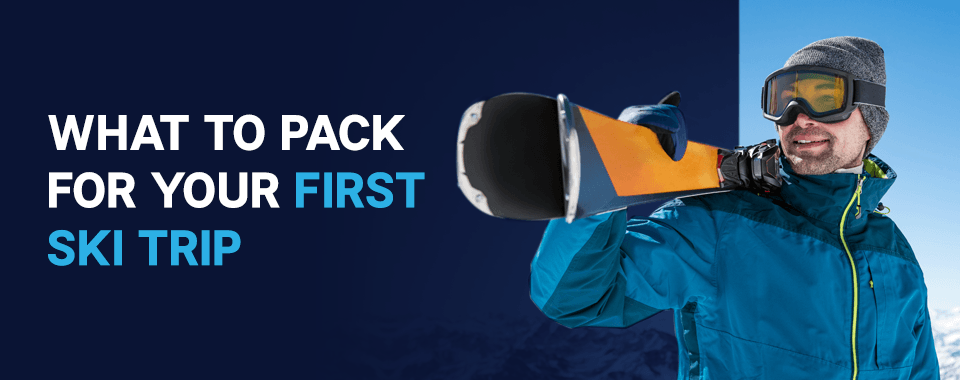 what to pack for your first ski trip
what to pack for your first ski trip
What to Pack for Your First Ski Trip
Posted
by
Matt Gahman
on Friday, May 19, 2023
Your first ski or snowboarding trip is an exciting time. You will experience a sport loved by people across the globe and gain a pastime that you can enjoy for years to come. But as you prepare for your first ski trip, you may find yourself wondering what equipment you need for skiing and what you should wear on the slopes.
Having a packing list of the essentials can ensure you pack everything you need. If you need to know what to take skiing for the first time, follow our skiing checklist for beginners so you can hit the slopes like a pro.
- Ski Gear Essentials for Beginners
- What to Wear Skiing for Your First Time
- Other Useful Things to Bring Skiing
- Packing for Women
- Packing for Men
- Packing for Kids
- Packing for a Family
- What to Do If You Forget an Essential Item
Ski Gear Essentials for Beginners
Compared to your average vacation, planning a ski or snowboarding trip can be a much more daunting task. Instead of simply packing clothes and grabbing a beach bag, you will need various skiing gear and protective clothing. Selecting the right gear can be intimidating for a beginner. Use this list to make sure you have the gear you need when you go skiing:
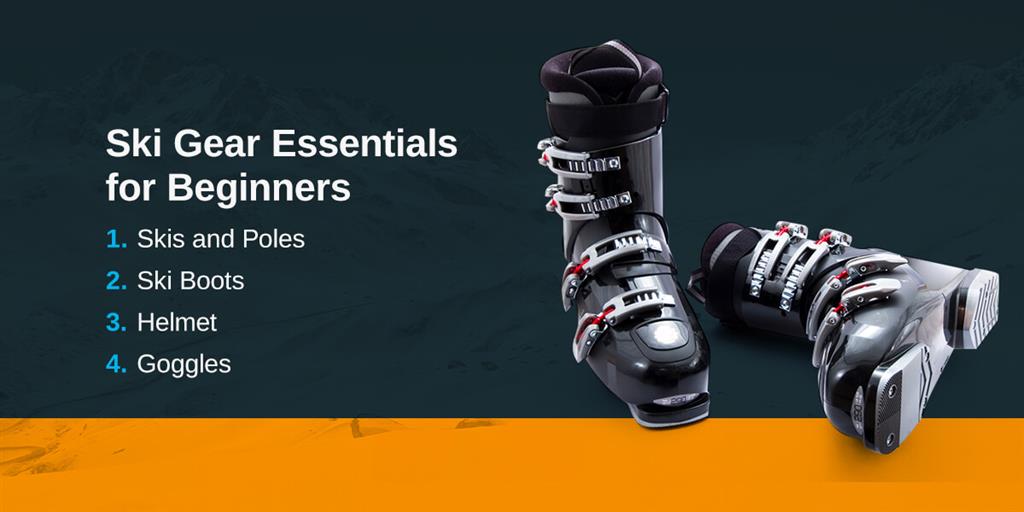
1. Skis and Poles
If it is your first time skiing, you may want to rent your skis and poles rather than buying them before your trip. Good skis can be expensive, so you may want to ensure skiing is for you before investing. The professional staff at the resort or rental shop will be able to fit you with skis and poles that are right for your skill level and height.
Often you will be able to get a good deal on higher-end skis when you rent. Once you fall in love with skiing — and we know you will — you will have an idea of what kind of skis and poles you want to buy.
2. Ski Boots
Having the right ski boots will greatly impact your comfort on the slopes, so it is best to buy your own pair. Ask a professional at the ski shop to help you find the right size and type of ski boots. Your ski boots should be snug but not too tight. When trying on boots, wear your insulated ski socks rather than your everyday socks, or you may end up buying boots that are too tight. There are also several ways a professional boot fitter can customize and adapt the fit of your ski boots to your foot.
If you do not want to purchase ski boots right away, you can rent them. However, rented ski boots may not fit as well, and you will want to go early to get the right size.
3. Helmet
Wearing a ski helmet is essential, especially for a beginner. When you are still learning, you will likely take a tumble or two and want to ensure your head is protected. It is better to be safe than sorry when concussions and head injuries are a possibility. Ski helmets also provide the extra benefit of keeping your head warm against the winter chill. Many helmets come with features like adjustable vents and goggle integration.
4. Goggles
Ski goggles are essential for protecting your eyes against the elements. Packed snow and ice reflect the sun's rays and can cause a lot of glare. Goggles also allow you to see in snowy and rainy conditions. As you are flying down the hills at lightning speed, you will not want to be squinting in the wind and sun.
Goggles come in various styles, including anti-fog and goggles with interchangeable lenses for varying conditions. When purchasing goggles, it is best to try them on with your helmet to make sure they fit properly.
What to Wear Skiing for Your First Time
Now that you have your ski gear, you must answer the question of what to wear. Remember that you will be exerting a lot of energy while also facing freezing temperatures. Skiing and snowboarding can put stress on your body, especially if you are not wearing the right clothes to protect against the cold.
Each person's body responds differently to cold weather, so you want to consider how prone you are to feeling cold when looking for ski clothes that you will feel comfortable in. Use this ski shopping list to fill your bag with the right outfits for your first ski or snowboarding trip:
1. Base Layer
Your base layer is your first line of defense against the cold, making it one of the most important things in your ski bag. Your base layer should comprise a technical long-sleeved shirt and long pants or leggings that are tight-fitting, breathable and able to wick away moisture. A turtleneck or quarter-zip top provides extra protection against the wind.
Look for moisture-wicking material that will keep you dry and warm. Synthetic materials, such as polyester and nylon, and natural fibers, like wool and silk, are all great options. Never choose cotton as your base layer, however, because it will become saturated with sweat and get cold. Cotton kills!
2. Mid Layer
How thick you want your mid layer to be depends on how easily you get cold. Because the weather can change quickly in the mountains, you may want to bring a few different sweaters and fleeces. On warmer days, you may not need to wear a mid layer at all, but on cold days you will be grateful to have an extra wool sweater in your bag. Layering options with your mid layer choice combined with the right base layer are the first two steps in staying warm and dry!
3. Outerwear
Your ski jacket should be breathable and waterproof. You will be battling wind, snow and varying weather conditions on the slopes, so you want an outer layer that keeps out all forms of moisture. You should also look for a jacket that can seal at the bottom with a drawstring or powder skirt so snow does not get under it if you fall.
The best ski jacket will also have an attachment for your ski pass and a variety of pockets for your cellphone, chapstick and other essentials. Some jackets are shells, others are insulated, and some have removable, zip-in mid layers and hoods.
4. Ski Pants
Like your jacket, your ski pants should also be wind- and water-resistant to keep you warm and dry. Make sure your pants fit over your boots and are snug around your hips so they do not fall down. You may want to buy suspenders or a belt for an extra secure fit.
5. Ski Socks
Your feet will get cold the fastest, so you will want to invest in one or two good pairs of ski socks. It can be tempting to double up on regular socks instead, but this is not effective against the cold, can restrict your blood flow, and will cause your boots to not fit as well. Look for wool or synthetic ski socks designed for insulation and moisture-wicking. If you are very prone to getting cold, there are also battery-heated ski socks available. Many ski socks are also padded at the shins and other pressure points for added comfort.
6. Gloves or Mittens
Protect your fingers with warm and waterproof gloves or mittens. It is up to you which you prefer, but make sure they are flexible enough to grip your ski poles properly. You can also purchase glove liners and heat packs for extra warmth. Look for gloves with wrist straps you can attach to your arm. Should you ever need to remove your gloves on the chairlift, you'll be glad they are attached in case you drop them!
7. Neck Warmer
While skiing, your face and neck will experience a lot of wind chill. However, you should never wear a scarf while skiing as it can come loose and become a hazard. Scarves are also prone to shifting as you ski, leaving space for cold air to get in.
Neck warmers are a great alternative, as they are designed to stay in place the whole way down the slope. They are also warm and comfortable, providing you with the option to cover your neck and the lower part of your face as needed. Face masks are a good option if you want even more protection, and they can easily be stored in a pocket if you get too warm.
When selecting clothes for your ski or snowboarding trip, make sure they fit properly and are warm but not overly bulky, as you will want to be able to move freely. Always opt for waterproof and moisture-wicking materials to keep you warm inside and outside. What you wear will determine whether you are comfortable while having fun or miserably spending the whole day shivering.
Other Useful Things to Bring Skiing
Now that you are dressed in your finest ski clothes, you are probably itching to hop on the slopes. But before you head out on your ski or snowboarding trip, here are a few more things you may want to grab:
1. Disposable Warmers
Disposable hand and foot warmers are great for frigid days, as you can pop them in your gloves or boots easily. Adhesive body warmers are also available that help relieve stiffness or aches while keeping your torso warm. Toss a few warmers in your backpack in case you get chilly when you're out in the snow.
2. Sunscreen and Sun Protection Factor (SPF) Lip Balm
While it may seem odd to bring sunscreen to a ski resort, this is an essential item to pack. If you are lucky enough to have a sunny day, the ultraviolet rays reflecting off the snow can be powerful. You may head home with a goggle tan and chapped lips if you are not properly protected.
3. Water Bottle
Staying hydrated while you are skiing or snowboarding is extremely important. It can be easy to forget to drink water in the cold, but your body will exert a lot of energy, and you will likely sweat out a lot of moisture. Bring a water bottle that holds enough water to keep you hydrated during the day — and don't forget to drink it.
4. Backpack or Another Small Bag
If you plan to spend the whole day outdoors, you will want to bring a small bag to stash your things. Fill it with snacks, sunscreen, lip balm, tissues, a water bottle, a warm hat, a scarf for after the slopes and a medical kit. When you head back to the lodge after skiing, you can use the backpack for your helmet and goggles.
5. Medical Kit
When it is your first time skiing, you do not know how your body may react. Bring painkillers to combat headaches or other pain. You should also carry adhesive bandages or medical wrap so blisters cannot ruin your trip.
6. Aftercare Products
Your skin can take a beating from the dry mountain air, so you will want to bring a good moisturizer to refresh your skin at the end of the day.
7. After Ski Boots
Even when you are not on the mountain, you will still be trudging through the snow to get around the resort. You will want to bring an extra pair of boots to change into when you head in for the night. Some resort food areas will not allow you to come in with your ski boots on after a specific time, so it is best to have a change of footwear in your bag.
8. Woolly Hat
Have we mentioned that it is going to be cold? Remember to change into a cozy beanie or another warm hat when you put your ski helmet away at the end of the day.
9. Apres Ski Clothes
Some people prefer to hang out in the same clothes they wore on the slopes (most ski apparel is designed to be functional and fashionable); however, you may prefer to change out of your wet and sweaty gear into something more comfortable. Many ski lodges also have nicer restaurants, so you may want to dress up.
10. Swimsuit
Taking a dip in the hotel pool at the end of the day is a perfect way to relax your muscles. You may even be lucky enough to book a resort with a hot tub. Don't forget your swimsuit if you plan to take an after-skiing swim or soak in the hot tub.
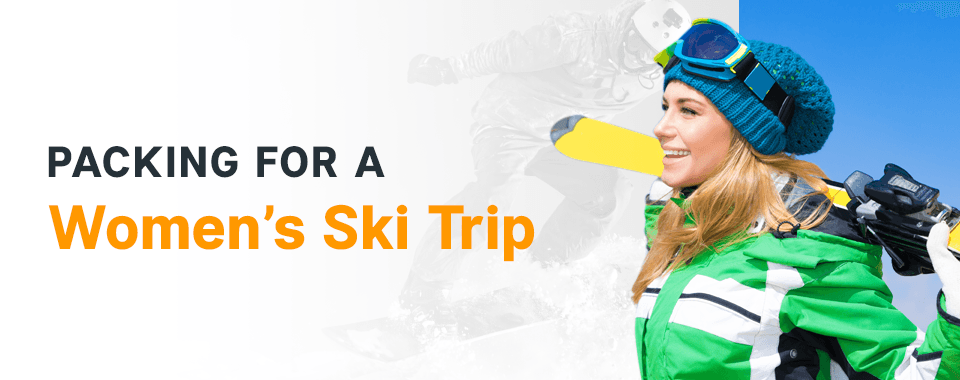
Packing for a Women’s Ski Trip
If you are heading out for a ladies' ski trip, you will want to be prepared to face the elements and look fashionable at the lodge. When packing for the slopes, remember that you will be breaking a sweat. Pack appropriate athletic gear as your base layer. If you plan to wear makeup while skiing, choose waterproof mascara and eyeliner so it won't run. Remember to pack something cute and cozy to enjoy the restaurants in the resort.
Below is a complete first-time skiing checklist for a women's ski trip:
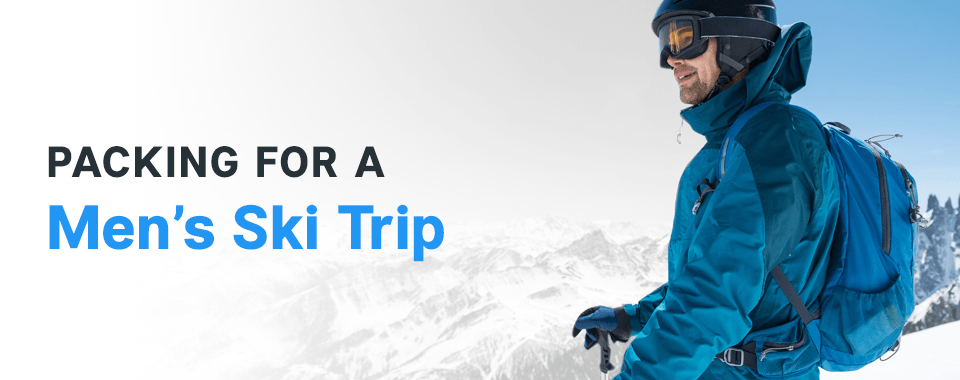
Packing for a Men’s Ski Trip
A guys' ski weekend can mean long, tiring days tackling the slopes. If you want to stay warm and dry, invest in the right equipment for the weather. Avoid simply tossing your gym clothes in your luggage, and instead choose a tight and warm base layer designed for skiing. Grab something stylish and comfortable if you plan to head out on the town at the end of the day.
Below is a complete first-time skiing checklist for a men's ski trip:
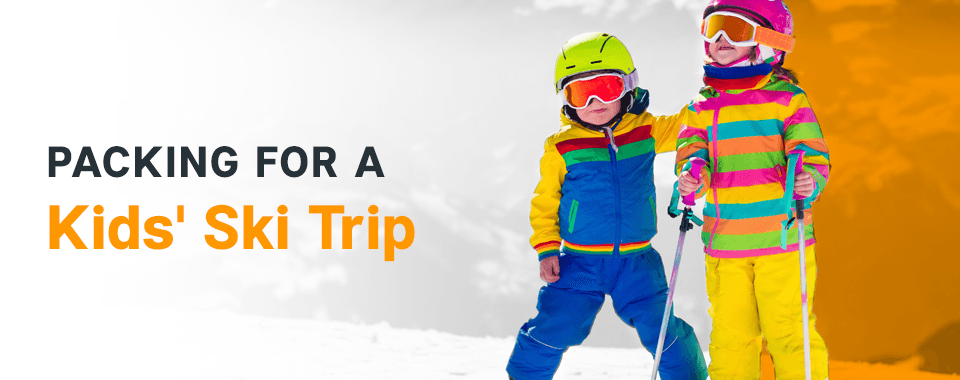
Packing for a Kids' Ski Trip
Taking your kids skiing can be an exciting experience as they learn how to ski or snowboard for the first time. However, you may not know if they will enjoy it or want to go skiing again. Renting gear for kids may be the best option so you are not investing in skis and helmets they may never wear again.
Kids also grow quickly, meaning they may need new equipment in a season or two. Renting gear for kids at the resort also means more room in the car for everyone else's equipment.
However, you will want to weigh the costs to decide if renting or buying is best for your family. If you plan to go on many trips in one season, it may be more affordable to buy gear for your kids and resell it when they grow out of it rather than paying a daily rental fee. If you have younger children, you may also be able to pass the gear down to them. Seasonal rentals from your local ski shop are also a great option.
Whether you rent or buy gear, you should purchase appropriate outdoor clothing for your kids. It is crucial to keep the little ones protected from the elements, so look for warm and moisture-wicking base layers and an insulated and waterproof outer layer.
While you and your friends may be willing to tough it out for another lap down the slopes, your shivering 5-year-old may cause you to cut the day short. Investing in good ski clothing will prove a worthy expense as the kids can wear them all winter for sledding, tubing or simply building a snowman in the backyard.
Below are a few extra things you may want to add to your ski shopping list if you are bringing kids on your ski trip:
1. Ski Lesson Tools
When a child is first learning how to ski, building confidence is half the battle. Every kid will fall a few times when they first strap skis to their feet, but encouraging them to get back up is essential to developing their skills. Using tools like an easy wedge or ski harness will help them do a little better, making them feel more confident as they learn.
A ski harness and leash can allow you to monitor their speed if they are going too fast and prevent them from crashing into a tree line if they have not mastered stopping yet. The ski harness can also be useful for helping kids get onto the ski lift.
Sleds or Tubes
If your child does give up on ski lessons for the day or needs a break, they can still enjoy the outdoors with a sled, tube or snow saucer. These activities often cost less than ski lessons but still allow you to keep enjoying the slopes.
Snow Toys
Another excellent break-time activity for kids is having a good old-fashioned snowball fight. For older kids, make the game more exciting with a snowball launcher or blaster. You can even bring a snow brick maker so they can build a fortress to defend.
To wrap it all up, here is a complete packing checklist for a kids' ski trip:
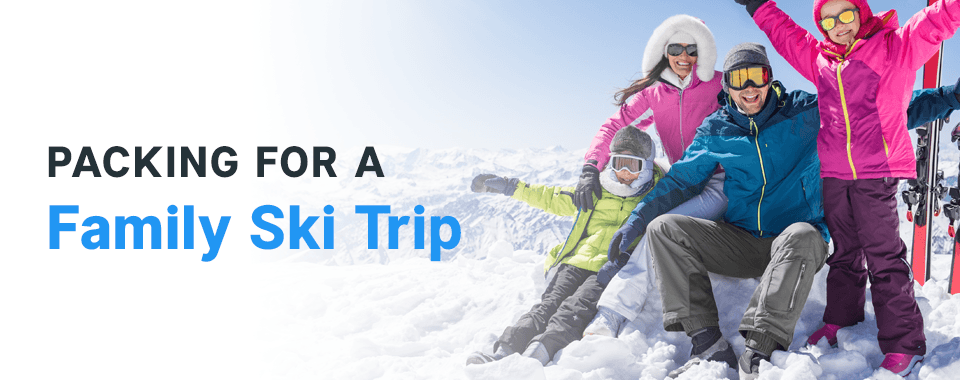
Packing for a Family Ski Trip
Packing for the whole family can be a stressful experience as you try to squeeze everyone and their gear into the car and still leave on time. You want to avoid arriving at the ski resort and realizing you have left someone's snow boots or skis behind. Below are a few tips to help you remember everything on your family ski trip:
1. Make Everyone Responsible for Their Own Things
If your kids are old enough to pack their own bags, give them a checklist of everything they will need to bring. It is great to teach younger children to keep track of their own clothes and gear. Even better, when they get in the habit of packing their own bags, it will make packing even smoother on the next trip.
2. Separate Ski Gear and Other Clothes
Packing ski gear and ski-specific clothing in one bag and everything else in another is also a great way to ensure each family member has everything they need to hit the slopes. You can double-check ski bags quickly before loading them into the car. This action will save extra expenses as it is cheaper to buy an extra tube of toothpaste than to replace a pair of ski goggles at the resort.
3. Save Space by Sharing What You Can
Rather than having each family member bring their own tube of toothpaste or bottle of sunscreen, pack one for everyone to share. Sharing toiletries will save space in your bags that you can fill with souvenirs on the trip home.
4. Pack Snacks and Breakfast
A family ski trip can quickly become expensive, so you may want to save money by packing breakfast and snacks. When you bring granola bars or instant oatmeal for breakfast, you also save time by skipping waiting in line for breakfast at the lodge.
5. Bring Entertainment for the Trip
Whether driving or flying to your ski destination, you may want to bring something to entertain the kids on the way there. Download some movies to watch in the car or bring coloring books for the flight. Having a peaceful trip to the ski lodge will leave everyone relaxed and ready for a fun-filled weekend.
What to Do If You Forget to Pack an Essential Ski Item
Arriving at the slopes to remember that your new goggles are sitting on the kitchen table can put a damper on your ski trip. Even with a packing list, the busyness and excitement of packing might mean you leave a few things behind, especially when packing several sets of gear for a family trip. Not to worry — you still have plenty of options to salvage your trip.
Purchasing New Equipment at Local Ski Shops
Your first option for restocking your gear is purchasing new equipment. Many ski locations have shops at the slopes or nearby for convenient access to anything you forgot. You can visit for everything from skis to clothing, even things like boots to wear around the lodge. Ski shops give you everything you need on and off the slopes for a fantastic vacation.
If you're skiing in the northeast, stop by one of seven Buckman's Ski Shops locations for friendly assistance with all the needed gear. We are a family-owned and -operated business with the best skiing brands and award-winning customer service to help you get the best experience for your day on the slopes.
Renting Equipment During Your Trip
If you're hesitant to repurchase gear that you forgot at home, you may choose to rent instead. Renting is cheaper than buying entirely new gear, and it's readily available at many ski shops. Buckman's Ski Shops let you rent various ski equipment, including skis, boots, bindings and poles. You can rent an entire set of equipment or rent only boots or a helmet at any of our seven locations across the northeast.
These rentals help you avoid the high costs of buying new gear while giving you quality options that you will feel safe and comfortable using during your ski trip. Buckman's ski rentals are available for men, women and children for weekly or weekend trips.
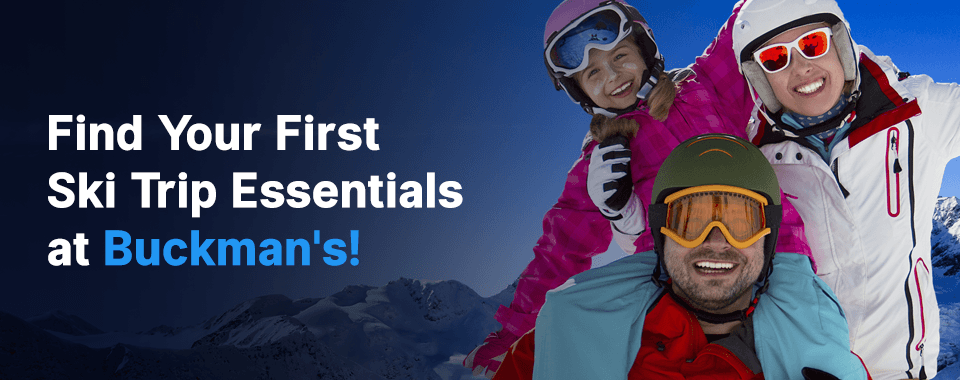
Find Your First Ski Trip Essentials at Buckman's!
Now that you know what to bring skiing for the first time, you can start looking for your perfect ski outfit and gear. Whether you are taking the whole family or heading out with your crew for the weekend, Buckman's has everything you need for your first ski or snowboarding trip. Bundle up with high-quality winter clothing and find the perfect set of skis.
Our passion for skiing and snowboarding has inspired us to provide only the best ski and snowboarding gear and expert repair services since 1971. At Buckman's, we pride ourselves in selling winter gear shipped to you directly from ski and snowboard shops, not some massive warehouse. Browse our inventory of ski clothing, equipment and more to find everything you need to make the most of your first ski trip.
Categories:
Ski & Snowboarding Tips
|
Ski & Snowboard Apparel